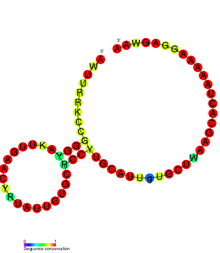SAM-V riboswitch
| SAM-V | |
|---|---|
 | |
| Conserved secondary structure of the SAM-V riboswitch. | |
| Identifiers | |
| Symbol | SAM-V |
| Rfam | RF01826 |
| Other data | |
| RNA type | Cis-reg; Riboswitch; |
| Domain(s) | Marine metagenome |
SAM-V riboswitch is the fifth known riboswitch to bind S-adenosyl methionine (SAM). It was first discovered in the marine bacterium Candidatus Pelagibacter ubique and can also be found in marine metagenomes.[1] SAM-V features a similar consensus sequence and secondary structure as the binding site of SAM-II riboswitch, but bioinformatics scans cluster the two aptamers independently. These similar binding pockets suggest that the two riboswitches have undergone convergent evolution.[2]
SAM-binding was confirmed using equilibrium dialysis. The riboswitch has been characterised as a 'tandem riboswitch' - it is able to regulate both translation and transcription. When SAM is present in high concentration, SAM-II will bind its ligand and form a terminator stem to halt transcription. If SAM exists in lower concentrations, SAM-V will be transcribed and, if SAM concentration should then increase, it can bind SAM and occlude the Shine-Dalgarno sequence of the downstream open reading frame. This regulation controls parts of the sulfur metabolism of marine bacteria.[2]
See also
References
- ↑ Meyer MM, Ames TD, Smith DP, et al. (2009). "Identification of candidate structured RNAs in the marine organism 'Candidatus Pelagibacter ubique'". BMC Genomics. 10: 268. doi:10.1186/1471-2164-10-268. PMC 2704228
 . PMID 19531245. Retrieved 2010-08-20.
. PMID 19531245. Retrieved 2010-08-20. - 1 2 Poiata E, Meyer MM, Ames TD, Breaker RR (November 2009). "A variant riboswitch aptamer class for S-adenosylmethionine common in marine bacteria". RNA. 15 (11): 2046–56. doi:10.1261/rna.1824209. PMC 2764483
 . PMID 19776155. Retrieved 2010-08-20.
. PMID 19776155. Retrieved 2010-08-20.
Further reading
- Kazanov MD, Vitreschak AG, Gelfand MS (2007). "Abundance and functional diversity of riboswitches in microbial communities". BMC Genomics. 8: 347. doi:10.1186/1471-2164-8-347. PMC 2211319
 . PMID 17908319. Retrieved 2010-08-26.
. PMID 17908319. Retrieved 2010-08-26. - Zhu Y, Pulukkunat DK, Li Y (2007). "Deciphering RNA structural diversity and systematic phylogeny from microbial metagenomes". Nucleic Acids Res. 35 (7): 2283–94. doi:10.1093/nar/gkm057. PMC 1874661
 . PMID 17389640. Retrieved 2010-08-26.
. PMID 17389640. Retrieved 2010-08-26. - Winkler WC, Breaker RR (2005). "Regulation of bacterial gene expression by riboswitches". Annu. Rev. Microbiol. 59: 487–517. doi:10.1146/annurev.micro.59.030804.121336. PMID 16153177. Retrieved 2010-08-26.
- Mandal M, Lee M, Barrick JE, et al. (October 2004). "A glycine-dependent riboswitch that uses cooperative binding to control gene expression". Science. 306 (5694): 275–9. doi:10.1126/science.1100829. PMID 15472076. Retrieved 2010-08-26.
- Yooseph S, Sutton G, Rusch DB, et al. (March 2007). "The Sorcerer II Global Ocean Sampling expedition: expanding the universe of protein families". PLoS Biol. 5 (3): e16. doi:10.1371/journal.pbio.0050016. PMC 1821046
 . PMID 17355171. Retrieved 2010-08-26.
. PMID 17355171. Retrieved 2010-08-26.